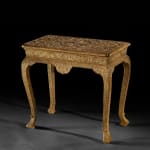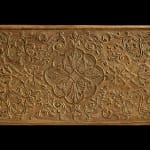Tables

Fig. 1: The 1755 inventory of Ombersley by Richard Callowhill, where the present table is possibly recorded. Interestingly, when the document was heavily amended by Samuel’s daughter-in-law, Anna Maria, who dated her corrections 1st July 1775, the entry in respect of the ‘gilt table’ was left untouched, suggesting the table had remained in its position between the windows in the Dressing Room between 1755 and 1775, the period during which, coming after the end of his political career, Sandys spent most time at Ombersley.
A GEORGE I GILT-GESSO TABLE
W: 29.75” / 77.5cm
D: 17.75” / 45.5cm
Further images
Provenance
Supplied to Samuel Sandys, 1st Baron Sandys (1695-1770) for Ombersley Court, Worcestershire, England
By descent with the Barons Sandys at Ombersley until acquired by Rolleston
DOCUMENTATION:
Ombersley Court Inventory, 1755, in ‘Inn the Drefsing Room’, ‘a gilt table between the windows carved.’
Literature
Arthur Oswald, ‘Ombersley Court, Worcestershire – I-III’, Country Life (January 1953)
Martin Davis, Samuel 1st Baron Sandys of Ombersley, 1695–1770: Fragments of Nine Lives, No. 1 (2017)
COMPARE:
The example at Erddig Hall, Wales, NT 1146957, illus. Bowett, A., Early Georgian Furniture, 1715-1740 (Woodbridge, 2009), pp. 210-13, pl. 5:19
See also G. Beard and J. Goodison, English Furniture 1500-1840 (London, 1987), p. 53, fig. 6
The Ombersley Court Table
Jewel-like in its smaller scale, the present gesso and giltwood table was made for a private room at Ombersley Court—almost certainly the Dressing Room adjacent to the Velvet Bedchamber—where it was likely recorded as the pier table “between the windows” in the 1755 inventory (Fig. 1).1
The exceptional quality of the carving—particularly the crisply modelled arabesques, shells, and floral ornamentation—points firmly to the hand of James Moore (c.1670–1726), cabinetmaker to George I and the most celebrated producer of gilt gesso furniture in early 18th-century England. Moore’s workshop, based at the sign of the Golden Fleece in St. Paul’s Churchyard, furnished the royal apartments at Hampton Court, Kensington Palace, and elsewhere, and became synonymous with the richly textured, French-inspired decorative style favoured by the highest levels of aristocratic and courtly patronage. His designs often feature boldly carved scrolling foliage, stylised shells, and naturalistic floral details—all evident in the present table.
The confident handling of the arabesque relief, the delicate flower-carved earpieces, and the finely balanced proportions align this table closely with other documented and attributed works by Moore. It bears strong visual comparison to a gesso table at Erddig Hall (NT 1146957), and the attribution is further supported by the survival at Ombersley of a group of gilt gesso pier glasses with close parallels to Moore’s documented commissions of the early 1720s. Taken together, these elements reinforce the likelihood that the present table is a rare and highly accomplished work from Moore’s workshop.
The table was commissioned by Samuel Sandys, later 1st Baron Sandys, a major figure in early Georgian politics. While his career in government was often turbulent, he remained a prominent and respected figure in Worcestershire, where he oversaw the construction and furnishing of Ombersley Court in the 1720s. Surviving notes and inventories suggest that Sandys took a close personal interest in the management and decoration of his estate, and the sophistication of this table’s design reflects both his political stature and aesthetic ambition.
Executed in the late Baroque style, the table features French-inspired ornamentation boldly modelled in gilt bas-relief and richly carved shells and foliage to the frieze. The cabriole legs—then an emerging innovation—depart from the earlier pillar-leg form and are here realised with elegantly scrolled feet and leaf-carved knees. The result is a compact yet lavish piece of early Georgian furniture: expressive, refined, and almost certainly the product of one of the finest cabinetmaking workshops of the period.




